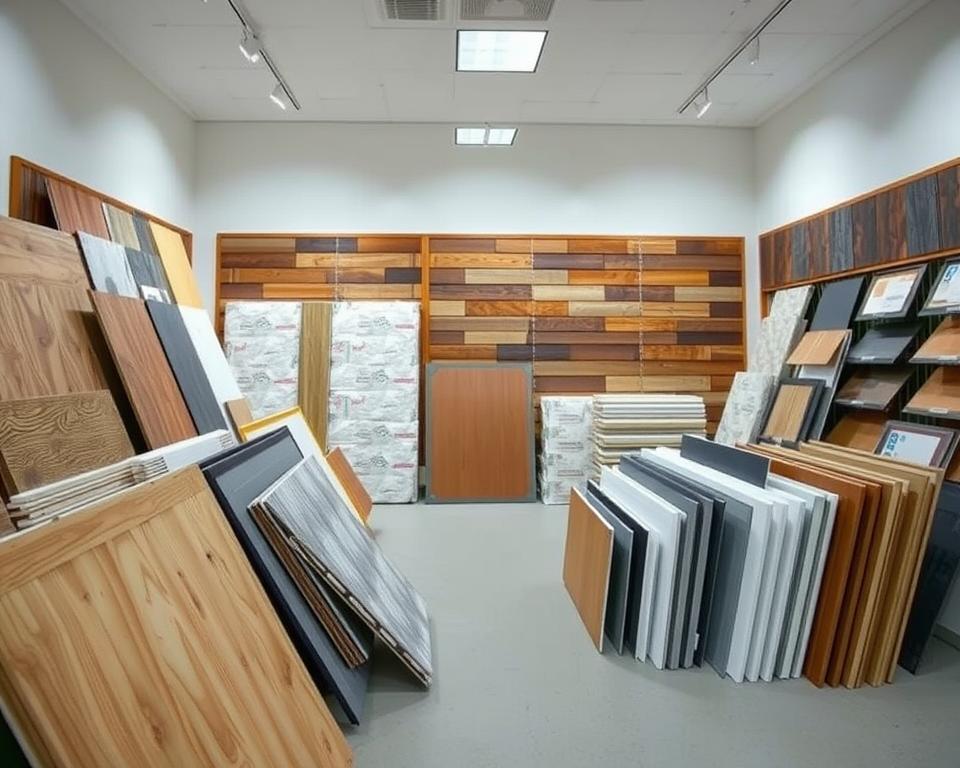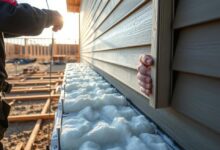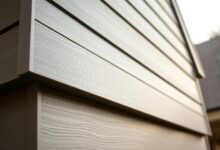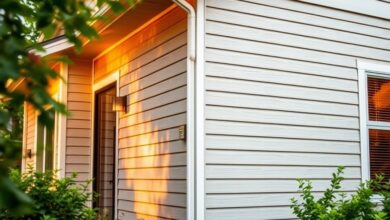Insulated Siding for Noise Reduction: A Step-by-Step Guide
Are you tired of the constant din of traffic or the chatter of neighbors disrupting your peaceful home life? Soundproofing your home can be a game-changer. One effective way to achieve this is by using insulated siding. This innovative solution not only enhances your home’s exterior but also significantly reduces unwanted noise.
By installing insulated siding, homeowners can enjoy a quieter living space. This improves overall quality of life. This guide will walk you through the process of using insulated siding for noise reduction. It provides a step-by-step approach to help you achieve a more serene home environment.
Key Takeaways
- Insulated siding can significantly reduce noise pollution.
- Soundproofing your home improves overall quality of life.
- A step-by-step guide will help you achieve a quieter home.
- Insulated siding is an effective home improvement solution.
- Enhance your home’s exterior while reducing noise.
Understanding Insulated Siding Technology
To tackle noise in your home, knowing about insulated siding is key. It’s not just for looks; it’s a system to block outside noise, save energy, and make your home last longer.
What Is Insulated Siding?
Insulated siding wraps your home in a layer of foam board insulation. Then, a strong finish like vinyl or fiber cement covers it. This combo creates a solid wall that keeps heat in and sound out.
How Sound Travels Through Walls
Sound moves through walls by vibrating them. When outside noise hits, it makes the wall vibrate, letting sound in. Insulated siding adds a layer to dampen these vibrations, cutting down on inside noise.
Types of Insulated Siding Available
There are many kinds of insulated siding, each with its own perks:
| Type | Description | Benefits |
|---|---|---|
| Vinyl Insulated Siding | A cost-effective option with a foam-backed vinyl exterior. | Energy-efficient, durable, low maintenance. |
| Fiber Cement Insulated Siding | A more premium option that combines fiber cement with insulation. | Highly durable, resistant to pests and fire, can mimic wood appearance. |
| Steel Insulated Siding | A robust option that pairs steel exterior with insulation. | Strong, secure, can be coated for additional protection. |
Each insulated siding type has its own benefits, from saving energy to looking great. Knowing these options helps homeowners choose the best for their home.
The Benefits of Insulated Siding for Noise Reduction
Insulated siding is a great way to cut down on noise. It makes your home quieter and more peaceful. This is perfect for those who want less noise.
Sound Transmission Class (STC) Ratings Explained
Insulated siding’s noise-cutting power is shown by its STC rating. STC ratings tell us how well a material blocks sound. The higher the rating, the more sound it blocks.
For example, a wall with an STC of 30-40 can get up to 50 or more with insulated siding. This makes a big difference in how much noise you hear.
Energy Efficiency Advantages
Insulated siding also saves energy. It adds an extra layer of insulation. This means less heat loss in winter and less heat gain in summer.
This leads to lower energy bills and a more cozy home. It’s a win-win for your wallet and comfort.
Increased Home Value and Comfort
Insulated siding boosts your home’s comfort and value. It makes your home quieter and more energy-efficient. This is a big plus for anyone looking to buy a home.
| Benefits | Description |
|---|---|
| Noise Reduction | Significantly reduces external noise with high STC ratings |
| Energy Efficiency | Lowers energy bills by reducing heat loss and gain |
| Home Value | Increases home value with energy-efficient and quiet features |
Assessing Your Home’s Noise Problems
Checking the noise levels in your home is the first step to a quieter living space. To cut down on noise, you must know where it comes from and how it affects you.
Identifying External Noise Sources
External noises can really change how your home feels. Things like traffic, nearby houses, and outdoor fun can make a big difference. Spotting these sources is key to finding the best ways to block out noise.
Measuring Current Noise Levels
To tackle noise, you must measure it first. You can use sound level meters or apps to do this. Knowing your home’s decibel levels helps set achievable goals for quieter living.
Setting Realistic Expectations
Insulated siding can help a lot with noise, but you should be realistic. How well it works depends on the siding type, insulation thickness, and your home’s structure. A detailed check helps plan the best way to reduce noise.
| Noise Source | Typical Decibel Level | Reduction with Insulated Siding |
|---|---|---|
| Traffic | 80-90 dB | 10-20 dB |
| Neighboring Homes | 60-80 dB | 5-15 dB |
| Outdoor Activities | 70-100 dB | 15-25 dB |
Selecting the Right Insulated Siding for Your Home
Choosing insulated siding means looking at different materials, how thick the insulation is, and what it looks like. It’s important to think about these things to get the best sound reduction and energy saving.
Material Options
Insulated siding comes in vinyl, fiber cement, and steel. Each has its own good points and not-so-good points.
- Vinyl siding is easy on the wallet and doesn’t need much upkeep but isn’t as tough as others.
- Fiber cement siding is durable and keeps out pests and fire but costs more.
- Steel siding is very durable and can look like other materials but can dent easily.

Insulation Thickness and R-Value Considerations
The thickness of insulation and its R-Value are key to your home’s energy use. A higher R-Value means better insulation.
Choosing the right insulation thickness depends on your climate, budget, and how much energy efficiency you want.
Aesthetic Choices and Design Options
Insulated siding comes in many styles and colors. This lets homeowners make their home look better. Think about your home’s style and what you like when picking.
Budget Considerations and ROI
Money matters when picking insulated siding. Some materials cost more at first but save money in the long run by using less energy and needing less upkeep.
Return on Investment (ROI) is also key. Good insulated siding can make your home worth more and give you a big ROI.
Step-by-Step Installation Guide for Insulated Siding
To get the best noise reduction, installing insulated siding right is key. This guide will help you prepare, install, and finish the job. This way, you or your installer can get the best results.
Preparation Phase
Before you start, make sure the site is ready and you have all the tools and materials.
Tools and Materials Needed
Make sure you have insulated siding panels, a moisture barrier, fasteners, and safety gear. Having everything ready will make the process smoother.
Safety Precautions
Always put safety first. Wear gloves, safety glasses, and a dust mask. Make sure your ladder is stable and consider having someone watch your back.
Removing Existing Siding
Take off the old siding carefully. Look for any damaged or rotten spots that need fixing. This is also a chance to check your walls and make any needed changes.
Installation Process
Now that you’re ready, start the installation.
Installing Moisture Barrier
Put up a moisture barrier to protect your walls from water. Make sure it’s aligned right and fastened well.
Mounting Insulated Panels
Start putting up the insulated siding panels from the bottom up. Use the right fasteners and spacing to hold them in place.
Seal all joints and edges to keep water out. Use a good sealant and follow the instructions.
Finishing Touches
The last steps are adding the finishing touches to your insulated siding.
Trim and Corner Installation
Put on trim and corner pieces to cover edges and improve your siding’s look. Make sure they’re fastened well.
Final Inspection Points
Do a detailed check to make sure everything is tight and there are no gaps or damage. Look for any water damage or other problems.
Common Installation Mistakes to Avoid
Watch out for common mistakes like wrong alignment, not enough fastening, and not sealing joints. Avoiding these will help your insulated siding work well and last long.
| Common Mistakes | Consequences | Prevention |
|---|---|---|
| Improper Alignment | Water Infiltration, Reduced Performance | Use Leveling Tools, Double-Check Alignment |
| Insufficient Fastening | Panels Loosening Over Time | Follow Manufacturer’s Fastening Guidelines |
| Failure to Seal Joints | Water Damage, Energy Efficiency Loss | Apply Sealant According to Manufacturer’s Instructions |
Conclusion: Maintaining Your Insulated Siding for Long-Term Noise Reduction
Insulated siding is a great choice for those who want less noise. To keep it working well, you need to take care of it. Simple steps can make your home quieter for many years.
Checking your siding often is important. Look for cracks or gaps and fix them right away. Also, keep it clean to help it block noise better.
Looking after your siding well makes it last longer. This means it will keep your home quieter and save energy for a long time.
By taking good care of your siding, you make your home quieter and protect your investment. Keeping it in good shape is essential for enjoying the benefits of insulated siding.




